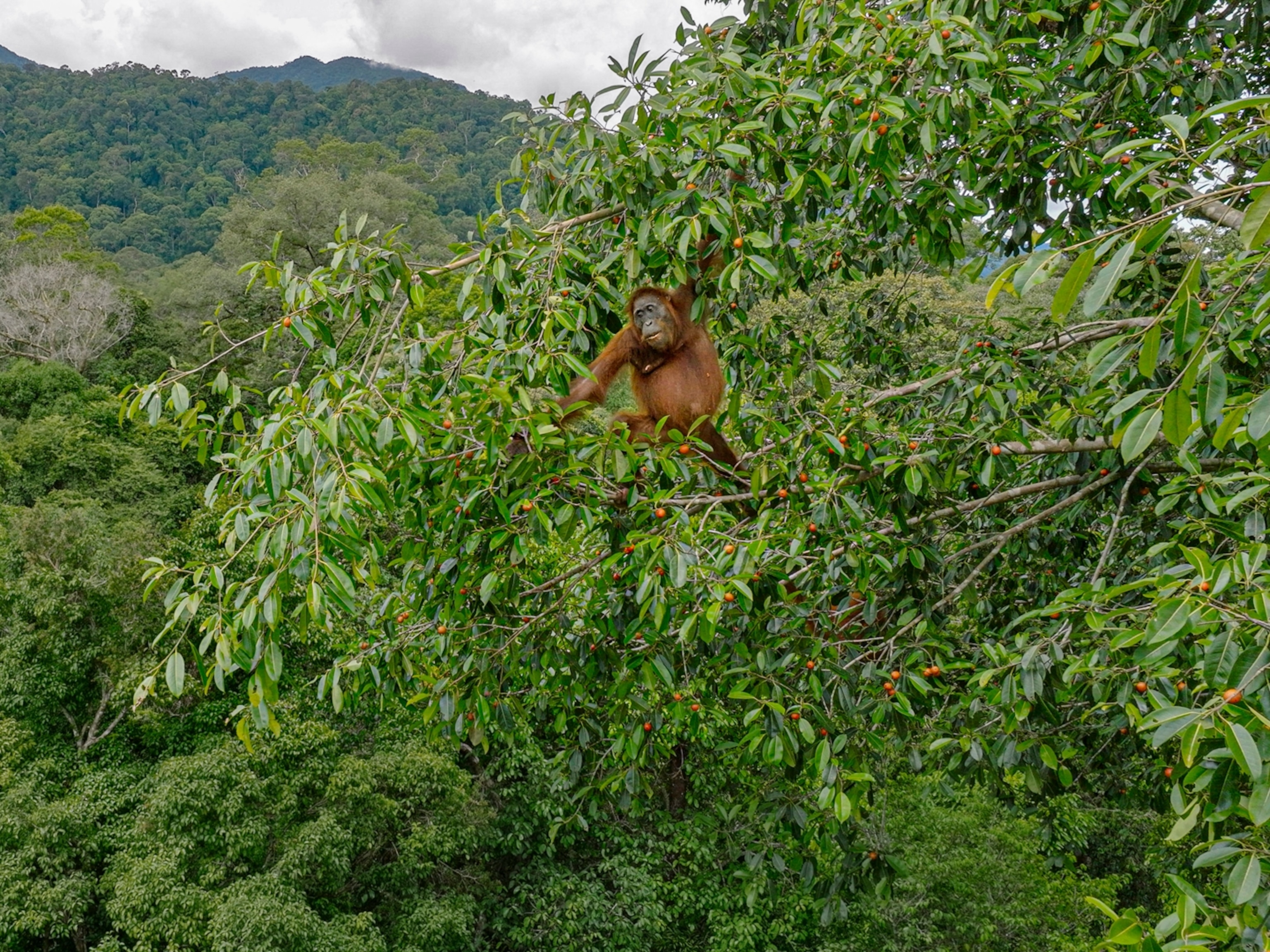
This ‘hand-washing’ orangutan went viral—but the story isn’t true
As the COVID-19 pandemic continues, more false animal stories are making the rounds. Long-term, the tales could undermine conservation efforts.
In November, the Center for Great Apes, a Florida sanctuary, posted a playful video to YouTube of resident orangutan Sandra scrubbing her hands with sudsy water. Then, a couple weeks ago, staff thought it would be cute and relevant to re-share the video to Twitter.
From there, a social media game of broken telephone ensued. People grabbed the video and reposted it with their own captions, draining it of context and—perhaps inadvertently—twisting the message. The story transformed: Sandra started washing her hands, it was said, because she saw her keepers doing so repeatedly during the COVID-19 crisis.
A lie was born, and ran rampant through social media.
Patti Ragan, the center’s founder, removed the video from the sanctuary’s YouTube channel on April 2, despite receiving dozens of requests from media outlets to license the footage. Ragan says she doesn’t want people to mistakenly think the center is teaching tricks to Sandra—the first orangutan in the world to be legally declared a non-human person—or any of the apes. “I’m just very conscientious about protecting her dignity,” Ragan says. “I took it down because I can’t control the message.”
Nor can she do anything about the thousands of misleading tweets that are already out there.
This story may feel familiar. Two weeks ago, National Geographic published a report that busted a number of similar myths—fake or misleading social media posts about animals behaving differently because of the coronavirus pandemic. More than 4.5 million of you read that story.
Some people criticized us for the myth-busting, seeing no harm in believing such tales. So we put the question to scientists—and several confirmed that in the long run, such fake stories do cause damage to conservation efforts.
The fake stories continue
The false stories keep popping up.
Some have been mundane: Ducks showing up in Roman fountains since the epidemic began got 28,000 upvotes on Reddit. In reality, the ducks are always there, commenters pointed out. Reddit moderators later removed the post.
Others have been absurd: Putin releasing 500 lions into Russian streets to keep people inside. It’s so fantastical that it shouldn’t need to be debunked, but the web mythbuster Snopes.com did so anyway. The photo that claimed to show a lion stalking a Russian street in fact was taken in Johannesburg, South Africa, in 2016 when a film production company let the big cat loose.
False tweets about wildlife flourishing during the pandemic have spread in India in particular. A photo that claimed to show deer lounging on the side of a southern India highway was actually taken in Nara, Japan, years earlier. A tweet stating that “while people are at home, nature is taking a heavy breath” showed a video of peacocks walking outside a national park, poking through garbage. According to some locals, however, the birds are frequently outside the park.
And a video that got 10,000 retweets claiming to show a rare, critically endangered Malabar civet strolling into a street in Kerala turned out to be of a common small Indian civet, an Indian Forest Service official later confirmed on Twitter. The animal might have been photographed after being released from captivity, the official wrote, noting that it looks quite sick.
But what’s really the harm?
After National Geographic published the original story, one question we received most frequently was: What’s the harm in believing a happy animal story, true or not? Some people contended that busting harmless white lies was akin to announcing that Santa Claus isn’t real.
But others defended the reporting. Jennifer Dodd, an ecology and conservation professor at Edinburgh’s Napier University, jumped in on Twitter to point out exactly what the harm was. “Miscommunication leads to people becoming disheartened,” she wrote, “leading to apathy [and] ultimately a reversal in conservation engagement.”
In other words: If people feel tricked or foolish for believing in an inspiring animal-recovery story that turns out to be fake, they may lose interest in conservation.

The idea that animals can bounce back when humans retreat also “overestimates the speed of the recovery,” Dodd said in a telephone interview. “It’s marginalizing the active conservation required to reverse the impacts we’ve had on the Earth.”
David Steen, a conservation biologist and reptile and amphibian research leader at the Fish and Wildlife Research Institute in Florida, echoes Dodd’s concerns. “Effective conservation efforts for many species now [require] intensive intervention, even in protected areas, and this work is not cheap,” he says. “I suspect that if most people thought all we had to do for species to recover is walk away, they may be less likely to support the work that actually needs to be done to keep them around.”
A scientist who frequently engages with people on Twitter about the importance of conservation, Steen says he wants people to appreciate wild animals for “what they really are. Relying on viral and untrue videos to make my case would only undermine this goal.”
Enjoying what’s real
In the past couple of weeks, as humans have withdrawn, there have been plenty of true stories of animal oddities. There’s the small herd of wild goats that have wandered through a Welsh town, delighting residents and the internet. The orcas spotted in an inlet close to Vancouver, in a rare sighting. Even the dolphins that were able to come a bit closer to docks in Sardinia (not Venice) because cruise ships weren’t crowding the port.
Perhaps the goats or boars or Sardinia dolphins brought you joy. If they also sparked a desire to protect nature, you’re in luck. Dodd says there are plenty of citizen science programs around the world that need individuals' help monitoring biodiversity—the presence and distribution of animals and plants— in their own communities. By participating in citizen science, she says, you “can actively help feed into how your landscape is managed.”
It’s still unclear how the global pandemic will affect conservation efforts in the long term. Dodd says that some of her students’ projects, which encompass “all ecosystems from parasites to mammals,” are now on hold and will likely suffer a year-long gap. (Her own study of invasive crayfish is set back; she wasn’t able to do fieldwork during a key breeding window.)
Dodd says she hopes that, ultimately, people who believed false stories about nature flourishing in humans’ absence will recognize the importance of conservation work. “There are points at which we’ve fundamentally altered the globe,” she confirms. “So it can’t recover at all without our intervention.”
- Tiger tests positive for coronavirus at Bronx Zoo, first known case in the world
- Fake animal news abounds on social media as coronavirus upends life
- Chinese citizens push to abolish wildlife trade as coronavirus persists
- Trafficked pangolins can carry coronaviruses closely related to pandemic strain
- The hunt for the next potential coronavirus animal host
You May Also Like
Go Further
Animals
- This ‘saber-toothed’ salmon wasn’t quite what we thoughtThis ‘saber-toothed’ salmon wasn’t quite what we thought
- Why this rhino-zebra friendship makes perfect senseWhy this rhino-zebra friendship makes perfect sense
- When did bioluminescence evolve? It’s older than we thought.When did bioluminescence evolve? It’s older than we thought.
- Soy, skim … spider. Are any of these technically milk?Soy, skim … spider. Are any of these technically milk?
- This pristine piece of the Amazon shows nature’s resilienceThis pristine piece of the Amazon shows nature’s resilience
Environment
- This pristine piece of the Amazon shows nature’s resilienceThis pristine piece of the Amazon shows nature’s resilience
- Listen to 30 years of climate change transformed into haunting musicListen to 30 years of climate change transformed into haunting music
- This ancient society tried to stop El Niño—with child sacrificeThis ancient society tried to stop El Niño—with child sacrifice
- U.S. plans to clean its drinking water. What does that mean?U.S. plans to clean its drinking water. What does that mean?
History & Culture
- Séances at the White House? Why these first ladies turned to the occultSéances at the White House? Why these first ladies turned to the occult
- Gambling is everywhere now. When is that a problem?Gambling is everywhere now. When is that a problem?
- Beauty is pain—at least it was in 17th-century SpainBeauty is pain—at least it was in 17th-century Spain
- The real spies who inspired ‘The Ministry of Ungentlemanly Warfare’The real spies who inspired ‘The Ministry of Ungentlemanly Warfare’
- Heard of Zoroastrianism? The religion still has fervent followersHeard of Zoroastrianism? The religion still has fervent followers
Science
- Here's how astronomers found one of the rarest phenomenons in spaceHere's how astronomers found one of the rarest phenomenons in space
- Not an extrovert or introvert? There’s a word for that.Not an extrovert or introvert? There’s a word for that.
- NASA has a plan to clean up space junk—but is going green enough?NASA has a plan to clean up space junk—but is going green enough?
- Soy, skim … spider. Are any of these technically milk?Soy, skim … spider. Are any of these technically milk?
- Can aspirin help protect against colorectal cancers?Can aspirin help protect against colorectal cancers?
Travel
- What it's like to hike the Camino del Mayab in MexicoWhat it's like to hike the Camino del Mayab in Mexico
- Is this small English town Yorkshire's culinary capital?Is this small English town Yorkshire's culinary capital?
- This chef is taking Indian cuisine in a bold new directionThis chef is taking Indian cuisine in a bold new direction
- Follow in the footsteps of Robin Hood in Sherwood ForestFollow in the footsteps of Robin Hood in Sherwood Forest







